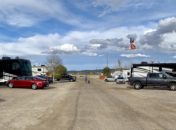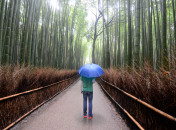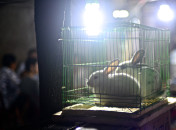Our journey was from Portree to Inverness, which has about 60,000 residents and is one of the fastest growing cities in Europe. The route was only about 160 miles but would take us from the fjords of Skye over the highlands and past the famous Loch Ness before leading us back into civilization. We took a longer route to see more of the highlands.
CROSSING THE HIGHLANDS
The first leg of the drive backtracked the road into Portree. Once across the bridge to the “mainland,” we headed northeast along Loch Carron, a broad grassy expanse sectioned into farms. Everywhere sheep grazed, poking their wee heads through the fences to munch on the greener grass. We then headed along a northern arc across the still-wild highlands and past ancient rocks and mountains, aubergine glens, crystal clear streams and sedate villages. We stopped at Shieldaig, a pretty village with cottages lined up along the shore front. The town was created in the early 19th century as a recruiting and training station for Highlanders to fight against Napoleon in the British Navy.
Another stop was at the Glen Torridon, which sits in a broad valley that contains some of the oldest rocks in the world – amazingly, they pre-date the emergence of life on earth. The northern horizon line is the dramatic silhouette of Beinn Eighe (pronounced Ben-Eh). Most of the ground within this protected glen is boggy, with great mounds of spiky grasses and heather. The Beinn Eighe National Nature Reserve was the first reserve created in Scotland and was established to protect the last remnants of the ancient pinewood forests.
We paused for lunch in the little village of Achnasheen at the Studio Jewelry Workshop. The café was dusty and grimy and all our meals were pretty bad except for the incredible potato and leek soup, which tasted good at the time but brought me a bellyache later. Asher bought himself a large quartz crystal to add to his rock collection. Later we drove past the ruins of the Beauly Priory, founded in 1230.
It was late afternoon as we rolled into the town of Drumnadrochit, home of several Loch Ness Monster shops, tours and exhibitions. We were looking forward to seeing the area as it is known to have a truly dark and spooky vibe, even if you don’t buy the monster story. Alas we arrived during a week of exceptional weather – 70 degrees, blue skies and a nice warm wind. Still we stopped along the loch and peered across in just in case Nessie wondered what the sun looks like.
DONNIE AND JEAN
The remainder of the drive took us into Inverness – a vibrant town that has the energy of Lincoln Park (Chicago) on a Friday night. There we met our wonderful hosts Donnie and Jean of the Birchwood B&B, who offered both whisky and a lively conversation about San Francisco (Donnie was in the Royal Navy and has been to California multiple times). After all the fish & chips joints we needed something special for dinner. Something non-Scottish. Non-European. We needed…Domino’s pizza. Okay, well, that wouldn’t have been our first choice, but it worked. For the second time on this trip, we grabbed Domino’s and settled into the lounge area of the B&B for our gourmet meal. Donnie offered a dram from his private collection of whiskies, and after an ad hoc flight of various brands I settled on a healthy pour of Glen Moray. Although Domino’s and scotch isn’t a normal pairing, it worked fine for me. Both Jean and Donnie were gracious and warm hosts who made our stay special.
THE WHISKY TRAIL AND THE INDIAN PALACE
The cold and rainy weather we expected in Scotland finally showed as we left Inverness to drive through one of the most famous whisky regions in the world, Speyside. The countryside was lush green and the roads were overhung with boughs of maple and elm. Our first stop was at The Glenlivet Distillery for a tour.
The Glenlivet is one of the largest single-malt whisky producers in Scotland and makes the biggest-selling single malt whisky in the U.S. We were excited to take the tour because it was an easy drive, free and reputed to be one of the best…not to mention that it was inside on a rainy day. The boys were fascinated by the working production facility (enormous machines, stills and milling equipment) and the smells. In the distillery portion of the tour, the buildings smelled like warm bread from the barley malts cooking and fermenting into grain alcohol. The cask building smelled like oak, charcoal, sherry and bourbon. The tasting at the end of the tour included more personal stories about the brand and the history of its founder.
The Macallan tour was longer and costlier with a more extensive tasting, so I went alone while the rest of the family waited and read their books. I was impressed by our tour guide’s storytelling skills more than anything else. Each step in the process brought forth a deep emotional backstory. He talked about the hard labor that went into the barrel building in Portugal, and then gushed about American woods – the Oregon pine for the washbacks and the Midwestern oaks for the barrels. The tasting session was laid back as he stepped behind the bar and presented a nip of four different whiskies – none of which are offered in the States. He also threw in a fifth glass of pure grain alcohol so we could taste it in comparison to aged whisky. It was horrible.
For dinner, we aimed for a downtown Inverness hot-spot (a hipster pub), but discovered that legally they can’t allow in kids after 8:00p, and it was 7:50. Most of the restaurants in the city center were pubs, but were were lucky to find Sam’s Indian Palace, where we loaded up on incredible curry, raita, rice, korma and naan.
A GIANT SEQUOIA IN SCOTLAND
We left the lively town of Inverness for the quiet countryside villages between it and Edinburgh. Our stop for a single night was the picturesque town of Pitlochry. The drive was short and mostly uninteresting on the A9, a major four-lane motorway. An early arrival at the B&B gave us time to kill, so we headed back north toward Blair Castle. That gave us reason to drive through Killiecrankie, the site of the famous Battle of Killiecrankie during the Jacobite Rebellion in 1689. Angela shared the story of “The Soldiers Leap” where one of William II’s supporters escaped the victorious Highland Charge by supposedly leaping 18 feet across the Garry River. There was some debate as to who among the four of us could make such a jump successfully.
We entered the castle grounds through massive iron gates and down a long drive between rows of lime trees. We were a bit “over-castled” and thus more interested in seeing it from the outside and walking the grounds. Adjacent to the main castle was a two-acre gated park of tall trees called Diana’s Grove, reputed to have many of the tallest trees in the UK. Several larch, red fir, douglas fir, and giant sequoia trees are numbered and identified. These include a giant sequoia grown from a seed collected from the Grizzly Giant, the largest tree in the Mariposa Grove at Yosemite National Park.
We walked by the ruins of the Old Blair Church and across cattle fields to Hercules Garden, a renovated 250 year old walled formal garden that includes artificial ponds and cultivated apple and pear trees. A small group of ducks approached Ronan and Asher, seemingly convinced that the boys had a treat for them. We strolled along the paths and enjoyed the peacefulness of the place.
THE BEST RESTAURANT IN SCOTLAND
The only thing that could have made the day better would have been a nice cozy meal in an old Scottish inn. Luckily we found that in The Logierait Inn – a dining space spread across four rooms in the downstairs of an inn founded in 1710. Self-described as “warm and snug with log fires, a friendly welcome and good honest food, well cooked with locally sourced produce,” it completely fulfilled every promise. The service was equally warm and honest, and the meal was one of the best we’d had since leaving California. As a point of historical significance, Logierait Prison once held the “Scottish Robin Hood,” Rob Roy, probably better known in the U.S. for the drink named after him. Cheers!
SOUTH TO EDINBURGH
We walked around the little town of Pitlochry, which was in the midst of prepping for the Ryder Cup in Gleneagles. Everywhere banners and posters welcomed visitors arriving for the annual “Olympics” of golf. The town is consistently Victorian in style – the buildings throughout the city center use the same stones, and the north side of the main road includes an ornate iron canopy. There were lots of gift shops and plenty of places to buy whisky.
Back on the road, we headed south to Edinburgh via the most direct route to return our car, but with a few stops along the way. The first visit was to Dunkeld Cathedral along the River Tay in Dunkeld, Perth and Kinross. Since the building of the church began in 1260 and didn’t finish until 1501, there are parts in ruins and parts still in use. The setting was very tranquil – large stones marking prominent figures in the cemetery, a broad tree-covered lawn down to the river and sunlight shifting shapes as the larch swayed in the breeze. The town of Dunkeld sits in an area that had been occupied first by the Picts in the 800s, and feels very much like a village untouched since the 18th century.
CASTLE ANTHRAX
Our next stop was Doune Castle in the village of Doune. The castle has been rebuilt (something we weren’t as keen on, preferring ruins), but was done in the 1880s true to the original. The self-guided tour took us throughout the courtyard, halls and guest rooms to the roof, which afforded us a view of the beautiful region. We later ranked the castles we’d seen on the trip and this one came in second place behind Kilchurn. Doune is a rather famous place among movie fans as Castle Anthrax in Monty Python and the Holy Grail. “Oh, wicked, bad, naughty, evil Zoot!”
The final stop was Stirling Castle. It is an enormous and imposing structure looming over the village of Stirling on a pyramidal promontory of whinstone. After climbing up a steep series of switchbacks to the castle (it’s easy to see why it was often besieged but never defeated), we entered through the gates. Given the time of day and nearly $100 tour cost, we shortened our visit and instead jetted down to Edinburgh, arriving at Hotel Ceilidh-Donia to settle into a relaxing night.
A DOUBLE-LOOP THROUGH EDINBURGH
Throughout our time in Scotland, vigorous winds buffeted countless billboards, placards, flags, kiosk wraps, lamppost stickers and posters with a single word on them – “Yes” or “No,” – promoting a singular position on the subject of Scottish independence. Though we had many open discussions with our newfound friends, this subject was never mentioned, and we didn’t ask. We sensed it was something deeply personal to be left out of polite conversation. That said, the referendum was only one week away and the public noise was heating up.
High grey clouds that filtered the direct sun but let through warmth made our two mile walk into the city center rather nice. Whenever we stopped to pull out the map or look around for street names, locals paused to ask if we needed any help. We had limited time in Edinburgh and wanted to see as much as possible, so took one of those double-decker sightseeing buses that loop the Old Town. It’s the “tourist’s tourist” thing to do when unsure of what you want to do first. We’ve done this before in London, Dublin and Paris and it works to provide a feel for where you might want to spend more time. Our plan was to jump off near the Grassmarket or the Royal Mile area, but we missed the stops and ended up looping the city twice. We didn’t really mind since it gave us time to notice new things, plus Asher discovered the Horrible Histories narration on our second loop.
Edinburgh is the capital and cultural hub of Scotland. It is also a World Heritage Site with more than 4,500 buildings listed for their architecture significance. From the John Knox House dating back to 1470 to St. John’s Church, the combination of medieval and neoclassical architecture gives the capital a unique vibe. Even the ultramodern Scottish Parliament building somehow fits right into a city trying to balance its past and present.
It was our last night in Scotland, as the following day we would take the train to London. From castles perched on promontories rising from brooding lochs to character-building highlands of stones older than life itself, Scotland’s cultural significance was impressive and photogenic. But what will stay with us was the warmth and generosity of the people.
CLICK ANY PHOTO TO OPEN THE GALLERY.


















































































